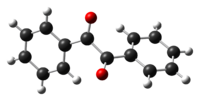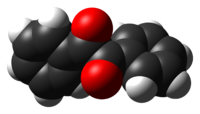- Benzil
-
Not to be confused with benzyl.
Benzil 

 1,2-diphenylethane-1,2-dioneOther namesdibenzoyl
1,2-diphenylethane-1,2-dioneOther namesdibenzoyl
bibenzoyl
diphenylglyoxalIdentifiers CAS number 134-81-6 
PubChem 8651 ChemSpider 8329 
ChEBI CHEBI:51507 
ChEMBL CHEMBL189886 
Jmol-3D images Image 1
Image 2- O=C(C(=O)c1ccccc1)c2ccccc2
c1ccc(cc1)C(=O)C(=O)c2ccccc2
Properties Molecular formula C14H10O2 Molar mass 210.23 g mol−1 Appearance yellow crystals or powder Density 1.23 g/cm3, solid (1.255 g/cm3, x-ray) Melting point 94.43-95.08 °C, 201.97-203.14 °F, 367-368 K
Boiling point 346- 348 °C, 654.8-658.4 °F, 619-621 K
Solubility in water insoluble Solubility in benzene soluble Structure Crystal structure P31,221[1] Dipole moment 3.8 D[2] Hazards Main hazards Irritant NFPA 704 Related compounds Related diketones biacetyl Related compounds benzophenone
glyoxal
bibenzil (verify) (what is:
(verify) (what is:  /
/ ?)
?)
Except where noted otherwise, data are given for materials in their standard state (at 25 °C, 100 kPa)Infobox references Benzil (systematically known as 1,2-diphenylethane-1,2-dione) is the organic compound with the formula (C6H5CO)2, generally abbreviated (PhCO)2. This yellow solid is one of the most common diketones. Its main use is as a photoinitiator in polymer chemistry.[3]
Contents
Structure
The compound's most noteworthy structural feature is the long carbon-carbon bond of 1.54 Å, which indicates the absence of pi-bonding between the two carbonyl centers. The PhCO centers are planar, but the pair of benzoyl groups are twisted with respect to the other with a dihedral angle of 117°.[4] In less hindered analogues (glyoxal, biacetyl, oxalic acid derivatives), the (RCO)2 groups adopts a planar, anti-conformation.
Applications
Most benzil is consumed for use in the free-radical curing of polymer networks. Ultraviolet radiation decomposes benzil, generating free-radical species within the material, promoting the formation of cross-links.
Reactions
Benzil is a standard building block in organic synthesis. It condenses with amines to give diketimines ligands. A classic organic reaction of benzil is the benzilic acid rearrangement, in which base catalyses the conversion of benzil to benzilic acid. This reactivity is exploited in the preparation of the drug phenytoin. Benzil also reacts with 1,3-diphenylacetone in an aldol condensation to give tetraphenylcyclopentadienone.
Preparation
Benzil is prepared from benzoin, which in turn is easily obtained via the benzoin condensation from benzaldehyde.[5]
- PhC(O)CH(OH)Ph + 2 Cu2+ → PhC(O)C(O)Ph + 2 H+ + 2 Cu+
References
- ^ Acta Cryst. B43 398 (1987)
- ^ Spectrochim. Acta A60 (8-9) 1805 (2004)
- ^ Hardo Siegel, Manfred Eggersdorfer "Ketones" in Ullmann's Encyclopedia of Industrial Chemistry Wiley-VCH, 2002 by Wiley-VCH, Wienheim. doi:10.1002/14356007.a15_077
- ^ Quang. Shen, Kolbjoern. Hagen "Gas-phase molecular structure and conformation of benzil as determined by electron diffraction" J. Phys. Chem., 1987, 91 (6), pp 1357–1360. doi:10.1021/j100290a017.
- ^ Clarke, H. T.; Dreger.E. E. (1941), "Benzil", Org. Synth., http://www.orgsyn.org/orgsyn/orgsyn/prepContent.asp?prep=cv1p0087; Coll. Vol. 1: 87
Categories:- Aromatic ketones
- O=C(C(=O)c1ccccc1)c2ccccc2
Wikimedia Foundation. 2010.

